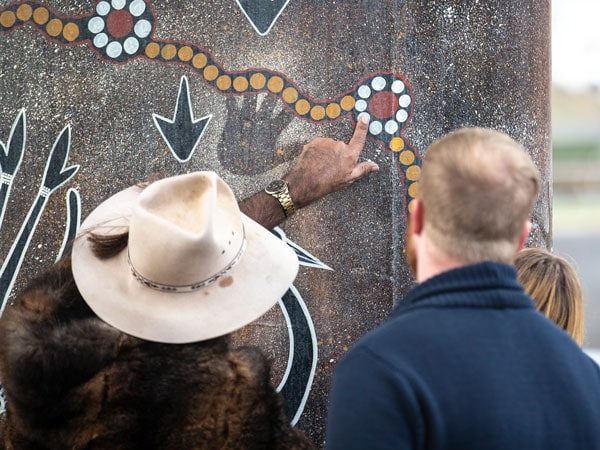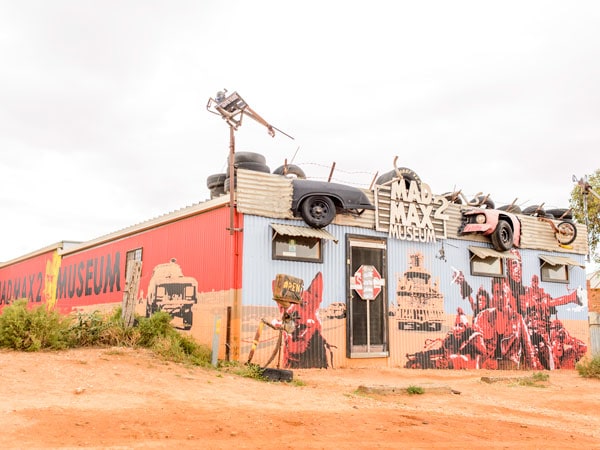March 24, 2021
![]() 6 mins Read
6 mins Read
Red earth, vast skies, vast floodplains and bony, rugged landscapes meet in western NSW, best explored on a traditional outback road trip with dust behind your car and adventure up ahead. Wide-open spaces and national parks provide inspiring landscapes where kangaroos bounce, emus flee and seasonal lakes and rivers are loud with migrating waterbirds.
Watch the video below for a taste of what awaits you along Central to Outback NSW…
The eye-squinting, soul-expanding horizons lure you on to adventure, whether you’re a Mad Max or Priscilla type of traveller. Meanwhile, heritage attractions range from ancient Aboriginal rock art to colonial-era history and modern-day mining towns. Settle into a pub and you can be sure a bearded miner, outback eccentric or traditional Aboriginal owner will have a tale to tell.
These are the happy, expected experiences on a Central-to-Outback road trip, but there are abundant surprises, too, not least increasingly sophisticated restaurants and regional museums, some avant-garde architecture and a thriving arts scene.
Buckle up for the 790-kilometre drive in Dubbo, where your first surprise might be that giraffes have blue tongues, and wombat poo is shaped like a cuboid. The kids will love all this and much more at Taronga Western Plains Zoo.

Get up close to the animals at Taronga Western Plains Zoo.
Cycle or drive its six-kilometre circuit for a leisurely encounter with 4000 creatures in a safari-like setting. For an extra thrill, stay at a luxury Zoofari Lodge, and take a behind-the-scenes tour with a zookeeper.

Visit Old Dubbo Gaol for an interactive history lesson. (Image: DNSW)
While the zoo is a must, Dubbo has other attractions, including a cellar door at Red Earth Estate and historic – and somewhat spooky – site Old Dubbo Gaol. For the region’s connections with Indigenous culture, take a First Lesson Cultural Tour with Wiradjuri elder Peter Peckham.

Take a First Lesson Cultural Tour with Wiradjuri elder Peter Peckham. (Image: DNSW)
As you head west, Nyngan is the last agricultural town before sun-kissed wheat fields give way to red earth. The town’s bright-red, historic railway station houses a museum detailing Nyngan’s boom-and-bust heritage.
Connect with culture on an Aboriginal art walk at Mount Grenfell and discover the painted figures of animals, people and Dreamtime stories of the Ngiyampaa people. Active travellers will enjoy kayaking on Macquarie Marshes. As you journey onwards, watery reflections are soon left behind and flamboyantly arid landscapes take over.
At Cobar you’re now deep in the outback. The town’s grand colonial churches, pubs and houses are a reminder of Cobar’s first flourishing during the 1870s gold rush, which you can learn more about at the Great Cobar Heritage Centre, set to reopen soon following renovations. Gold and copper are still being mined here; Fort Bourke Hill Lookout allows for a gobsmacking look into an open-cut mine.

At Cobar you’re now deep in the outback. (Image: DNSW)
You might stay in one of several motor inns or Cobar Caravan Park, but this driving adventure offers a great variety of accommodation, from a cottage on a working cattle station to rooms above an old-time pub. You might also opt for the charm of a B&B, heritage homestead or national-park campsite under the stars.

Visit the Great Cobar Heritage Centre and Cobar Miners Heritage Park. (Image: DNSW)
Wilcannia, once one of the busiest inland ports in Australia thanks to the wool trade, is now slumped in the gum-scented heat of the outback. Sandstone colonial-era buildings – police station, post office, wool stores – attest to the settler history of this atmospheric town on the Darling River, which shimmers with sunsets and the silhouettes of paddling pelicans.

Wilcannia was once one of the busiest inland ports in Australia. (Image: DNSW)
Make a detour north to Paroo-Darling National Park. It might be 1200 kilometres from the ocean, but you can spot pelicans among its teeming birdlife, which includes emerald-green mulga parrots, pink cockatoos and bustards, one of Australia’s largest flying birds.

Find rock pools in colourful gorges in Mutawintji National Park. (Image: DNSW)
Another worthy excursion takes you to Mutawintji National Park, close to the home of the rare yellow-footed rock wallabies. Rock pools in colourful gorges provide a reliable water supply that attracts corellas, zebra finches and wedge-tailed eagles. But the national park also features one of NSW’s best rock-art collections, best explored with an Indigenous guide from Mutawintji Heritage Tours.
Head towards Broken Hill over scorched orange plains and silvery saltbush under a vast sky. The immensity of the landscape is both intimidating and exhilarating, but if you expect Broken Hill to be no more than a hard-core, isolated mining town, think again.

Sunrise over Broken Hill. (Image: DNSW)
You’ll want to linger for heritage buildings, museums and varied restaurants. Broken Hill has also been a vibrant creative centre since the 1960s, and boasts dozens of art galleries and studios and the largest regional public art gallery in NSW.

Don’t miss Broken Hill Regional Art Gallery. (Image: DNSW)
Also encouraging you to linger are great accommodation choices, from the restored miner’s home Hebbard Cottage to the stunning Broken Hill Outback Resort. And who could resist an evening (or two) at The Palace Hotel, the mural-clad pub made infamous in Priscilla, Queen of the Desert.

Visit Mad Max Museum in the ghost mining town of Silverton. (Image: DNSW)
Drive out to ghost mining town Silverton and you might find yourself with another sense of déjà vu, especially if you have a beer at the legendary Silverton Hotel. Some 140 television commercials have been filmed here, as well as numerous iconic movies including Mad Max, Priscilla and Mission Impossible II.

Have a beer at the legendary Silverton Hotel. (Image: DNSW)
The landscape is cracked into fissures across the Mundi Mundi Plains, splintered like a smashed pane of glass. Sunsets here are magnificent, but are perhaps even better at Living Desert and Sculptures on a hillside outside Broken Hill. As the sun sets with orange outback flamboyance behind rocky ridges and purple hills, you couldn’t be in a more inspiring place.
Make sure you stay up to date with the road conditions before you set off with the latest travel alerts at Visit NSW.

Catch a sunset at Living Desert and Sculptures. (Image: DNSW)
Download our beautifully-illustrated map of NSW’s best road trips (pictured below) or find the giant wall map inside issue 90 of Australian Traveller magazine.

Illustration: Mike Rossi
For the  best travel inspiration delivered straight to your door.
best travel inspiration delivered straight to your door.
LEAVE YOUR COMMENT